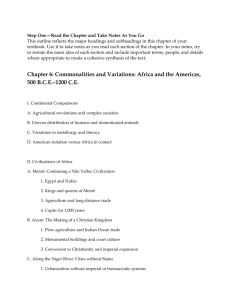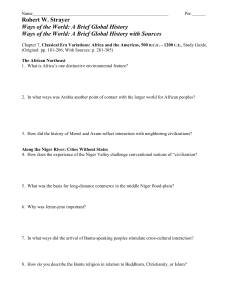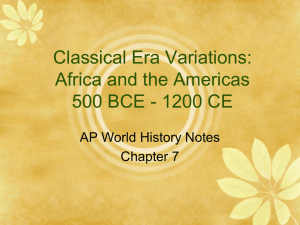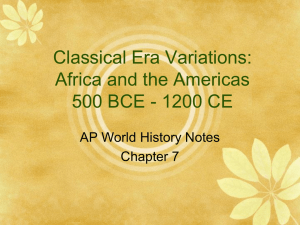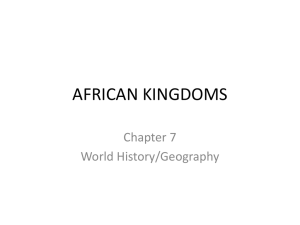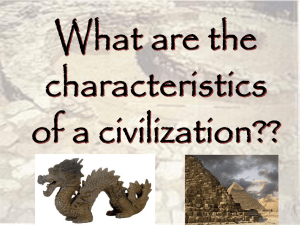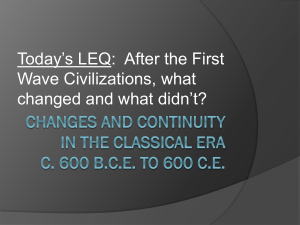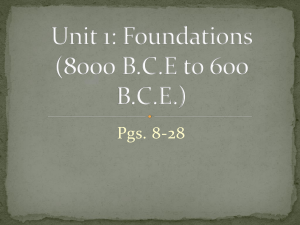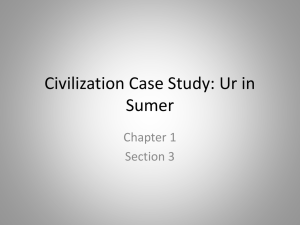America: A Concise History
advertisement
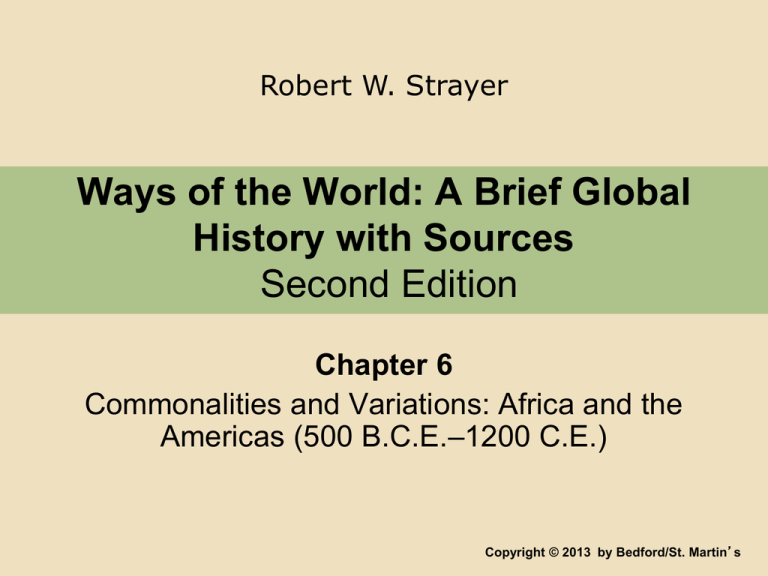
Robert W. Strayer Ways of the World: A Brief Global History with Sources Second Edition Chapter 6 Commonalities and Variations: Africa and the Americas (500 B.C.E.–1200 C.E.) Copyright © 2013 by Bedford/St. Martin’s I. Continental Comparisons A. Agricultural revolutions and complex societies B. Uneven distribution of humans and domesticated animals C. Variations in metallurgy and literacy D. American isolation versus Africa in contact Humankind started in Africa – spread to Eurasia, Australia, the America, and the Pacific Ocean Hunting and Gathering Each had an Agriculture Revolution independently of each other Complex societies followed – cities and start of civilizations Each had cities, grand buildings, social inequality Beginning of Common Era – 250 million people Unevenly distributed Eurasia – 80% / 11% Africa / and Americas 5-7 % America lacked Animals capable of domestication / did not develop pastoral society No draft animal except alpacas and Llamas in the Andes – Nothing to pull a cart or plow Africa lacked sheep, goats, chickens, horses, and camels / But being close to Eurasia meant they did become available Metallurgy was less advanced in America America writing limited to Mesoamerica region – highly developed by Maya / Africa limited to Northern and northeast Both had smaller populations and most of the people did not live in cities Northern Africa was part of the Mediterranean world Arabia – Camels to Africa – nomadic pastoral – Berber people – western Sahara Camels later used for commerce – connected West Africa toe Mediterranean world America – developed on its own until Columbus II. Civilizations of Africa A. Meroë: Continuing a Nile Valley Civilization 1. Egypt and Nubia 2. Kings and queens of Meroë 3. Agriculture and long-distance trade 4. Coptic for 1,000 years Civilizations of Africa Nubians south of Egypt Traded with Egypt – Kingdom of Kush conquered Egypt and ruled for a century While Egypt came under foreign control Nubia flourished – center – Meroe – 300 BCE – 100 CE Monarch – sacred – held at least 10 times by women Women leaders portrayed with prominence and power equal to male Rulers buried along with human who were sacrificed Meroe – merchants, weavers, potters, masons and servants, laborers and slaves Irion tools and weapons Rainfall was enough – irrigation not neededagriculture flourished Wealth and military power – from trading = profits Lion god Apedemek Meroitic writing Kingdom declined deforestation, trade routes switched – wealth diminished Kingdom falls to Axum – Later Nubian cities rise – Coptic, - Christian – 1,000 years Nubia was a Christian civilization using Greek language – Churches in Coptic or Byzantine fashion 1300 – Started to erode with Arab immigration and Islam – became part of Islamic world II. Civilizations of Africa B. Axum: The Making of a Christian Kingdom 1. Plow agriculture and Indian Ocean trade 2. Monumental buildings and court culture 3. Conversion to Christianity and imperial expansion Axum – located on the horn of Africa – south of Nubia near Red Sea Agriculture society that used a plow unlike most of Africa (used hoe or digging sticks) Wheat, barley, millet- abundance – led to the rise in population 50 CE developed in to a state – added by commerce via Red Sea and Indian Ocean Supplied Rome wth pearls, textiles, most important – peppers Port city – Adulis – merchants sought products from Africa’s interior – animal hides, rhinoceros horns, ivory, obsidian, tortoiseshells, and slaves The fall of Meroe and the rise of Axum – changing patterns of trade Axum center – huge stone obelisks (100 feet tall) Language – Geez Romans considered Axum a third major empire – Rome and Persian King Ezana 4th century CE adopted Christianity about the same time as Constantine Coins – earlier inscribed with different gods – later with a cross Axum linked with Egypt – Coptic Christian church had already been established Egypt later becomes largely Islamic Christianity – was still dominate in highlands of Ethiopia 4th – 6th century – Azum expanded – military to Monroe, across Red Sea to Yemen and Mecca gates Next several centuries Axum declined in power – due to soil erosion, climate change, deforestation and the rise of Islam II. Civilizations of Africa C. Along the Niger River: Cities without States 1. Urbanization without imperial or bureaucratic systems 2. Iron working and other specializations 3. Regional West African trade system Niger River Jenne-jeno – 40,000 people – cities but not city states – more independent but coexisting Remains show little sign of despotic power, warfare or inequality among people – resemble early cities of the Indus Valley Cities specialized – iron smithing, cotton weaving, potters, leather workers, and griots (singers who kept oral history) Cities developed occupational caste system- skills passed on to children and marriage in group only Supported farming – rich soil – Boat travel along Niger River – trade – evidence of widespread trade in Africa III. Civilizations of Mesoamerica A. The Maya: Writing and Warfare 1. As early as 2000 B.C.E. 2. Urban centers, mathematics, and astronomy 3. Engineered agriculture 4. Competing city-states 5. A century of collapse after 840 B.C.E. Mesoamerica Trade in this region enriched two areas – Mesoamerica and Andes First civilizations of America – Olmecs and Norte Chico Mesoamerica – from central Mexico to northern Central America Olmecs - Distinct region – shared technology of farming, common culture, ( maize, beans, chili peppers, squash) Religion – male and female gods – human sacrifice Calendar 260 days Hieroglyphic writing These cultures influenced other in Mesoamerica Mayas 2000 BCE evidence the Mayas existed this long ago Guatemala – Yucatan of Mexico 250-900 CE – Mathematics with 0, studied the sky and could predict eclipse Calendar – accurate solar year Writing – pictograph, phonetic (syllabic element) Peaceful civilization – temple building and intellectual pursuit Drained swamps, terraced hillsides, flattened ridge tops, and water management system Classes – Elite (nobles), priests, merchants, architects, sculptors, and labor force Fragmented political system in outlying areas– Local lords fought each other – sacrificed prisoners Urban centers – Kings and at times queens Devine rulers – state shamans – could talk with supernatural Tikal – major city – ruins exist Cities never unified Trade – Jade, gold, shells, feathers, Civilization collapsed Drought caused population to fall by 85% in southern region- famine and disease Northern region Mayas present at time of Spanish invasion Collapse like that of the Romans – high taxes, enemies, and too large to control III. Civilizations of Mesoamerica B. Teotihuacán: The Americas’ Greatest City 1. Planned, enormous, and still a mystery 2. 150 B.C.E.–650 C.E. 3. 100,000–200,000 inhabitants in 550 B.C.E. Teotihuacan – Valley of Mexico 550 CE population – 100,000 – 200,000 / Largest urban place in the Americas Not much is known about this Maya civilization – Language, government etc. Contains two giant pyramids – Pyramid of the sun Temple of the Feathered Serpent – 200 people’s remains found – sacrificed – hands and feet bound 300-600- CE 10,000 square miles controlled- tribute – large military took control of region Collapsed 650 CE mystery The Aztecs later named this Teotihuacan- city of the gods IV. Civilizations of the Andes A. Chavin: A Pan-Andean Religious Movement 1. Temple complexes centered around a village 2. Village became a major religious center 3. Links to all directions via trade routes Andes Pacific Ocean – fish, also potatoes – pasture land for llamas – cocoa and fruit Chavin -900 BCE settled in Andes 750 BCE a small town 2-3 thousand people – trade to both coasts and Amazon Deities – jaguars, crocodiles and snakes Used cactus as hallucinogenic Next few centuries – spread across Peru – cultural integration – no empire emerged IV. Civilizations of the Andes B. Moche: A Civilization of the Coast 1. 250 miles of coast, 100–800 C.E. 2. Elite class of warrior-priests 3. Rich fisheries and river-fed irrigation 4. Fine craft skills 5. Fragile environment Moche 200 BCE – Chavin cult faded – replaced by other civilizations Moche – 100 – 800 CE – Used irrigation – maize, beans and squash – acres of cotton and anchovies from ocean Governed by warrior priests – huge pyramids – sun dried bricks used Artwork suggest large scale sacrifice 8th century CE – civilization no longer exists IV. Civilizations of the Andes C. Wari and Tiwanaku: Empires of the Interior 1. 400–1000 C.E. 2. Highland centers with colonies in the lowlands 3. Distinctions between the two, yet little conflict 4. Collapse, but the basis for the late Inca Wari 400-1,000 CE Wari and Tiwanaku large urban centers – population in the tens of thousands Seafood, Chili peppers, maize, cocoa and hallucinogenic plants Wari – hillside terracing / Tiwanaku raised fields Collapse and later Incan claimed Tiwanaku as their place of origin V. Alternatives to Civilization: Bantu Africa A. Cultural Encounters 1. Migrations spread a common Bantu culture 2. Bantu strengths: numbers, disease, and iron 3. Bantu impact on the Batwa 4. Impacts on the Bantu in East Africa Bantu – Africa South of equator – second wave era Bantu speaking people spread Started 3,000 BCE by 100 CE they have iron making technology Migration leads to 400 closely related languages called Bantu Slow migration with families – gave this area a cultural and linguistic commonality Migration – farmers replaced hunters and gatherers / mixed cultures with each other Advantage to them? Population grew and would out number other groups They brought with them disease – killed many of the people in the lands they migrated to Iron tools and weapons also gave them an advantage V. Alternatives to Civilization: Bantu Africa B. Society and Religion 1. Wide varieties of Bantu cultures developed, 500–1500 2. Less patriarchal gender systems 3. Ancestor or nature spirits rather than a Creator God 4. Localized not universal faiths and rituals Central Africa – Batwa or pigmy people – forest specialists – honey, wild game, animal skins and medicinal bark and plants Traded with Bantu – adopted language Both groups developed chiefdoms Gender systems less patriarchal than urban areas Religion focused on nature spirits and ancestors Belief in witches – no missionary – explained predict and control local affairs VI. Alternatives to Civilization: North America A. The Ancestral Pueblo: Pit Houses and Great Houses 1. Slow start to agriculture and settled society 2. Chaco Phenomenon, 860–1130 C.E. 3. Astronomy and art but then warfare and collapse North America Pueblo 600-800 CE permanent villages – pit houses with floors sunk several feet below ground 900 CE included Kivas – used for ceremonies Belief that mankind emerged from the world below Local trading – Buffalo hides, copper, turquoise, sea shells, feathers and baskets Increased dependence on agriculture – population growth- led to above ground structures known as pueblos Chaco Canyon – North Western New Mexico – 8601130 CE – 5 major pueblos emerged= 25,000 square miles Highly skilled astronomers 11th century CE major center of turquoise and trade as far south as Mesoamerica 1200 CE inhabitants scattered – later became the Pueblo of modern times VI. Alternatives to Civilization: North America B. Peoples of the Eastern Woodlands: The Mound Builders 1. Independent agricultural revolution 2. Burial mounds of the Hopewell culture 3. Cahokia, 900–1250 C.E. 4. Social complexity but weaker cultural unity Mound Builders Mississippi River valley – 200-400 CE Hopewell culture Large burial mounds – some mounds aligned with moon – allowed prediction of eclipse Hopewell traded with region – leads to an exchange in culture and religious practices 800 CE – corn allowed for rapid growth -Cahokia - large city – today St. Louis – 900-1250 CE Elite – used laborers to build huge mounds – they were buried with much wealth

